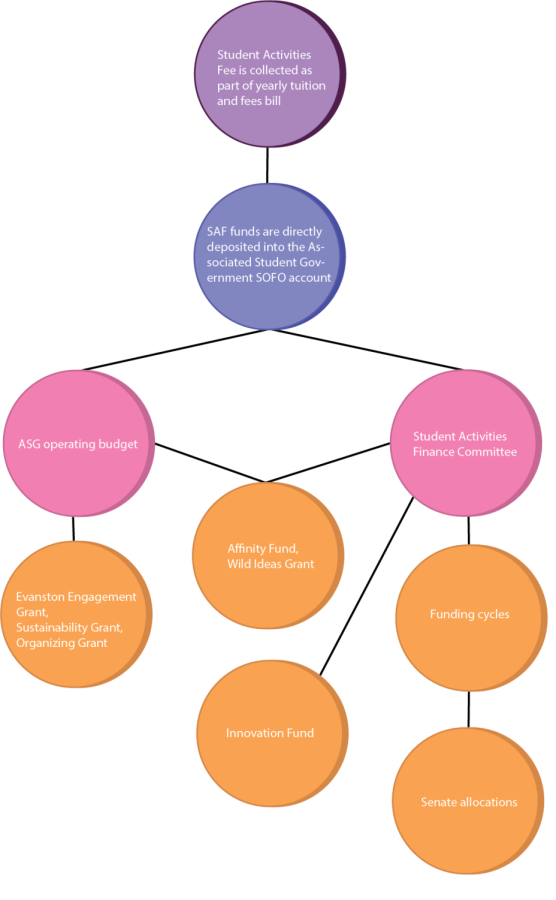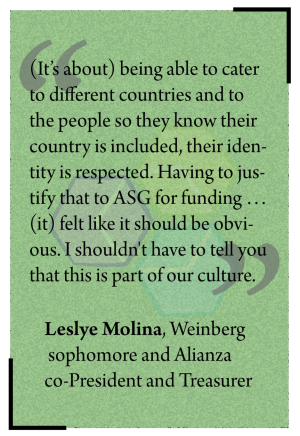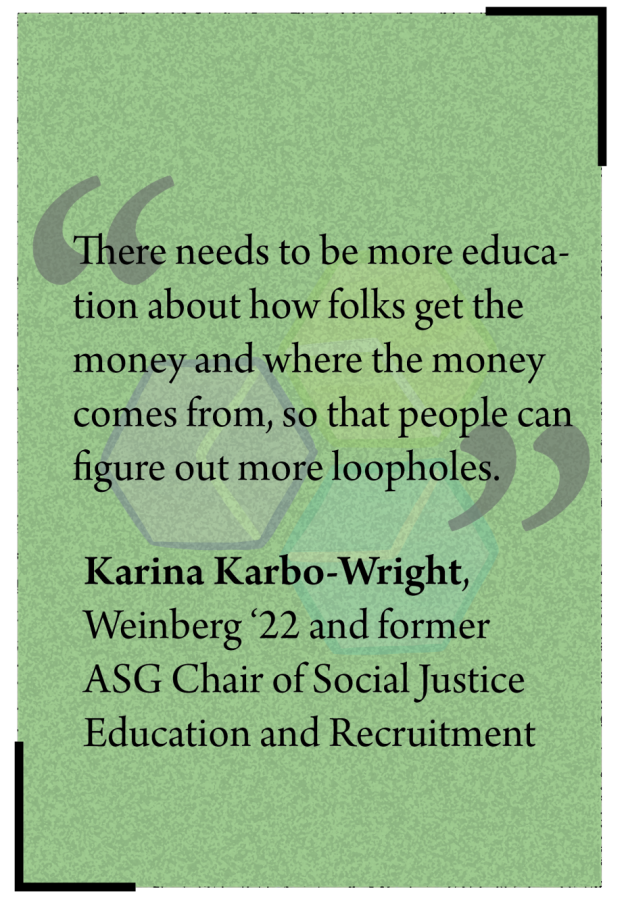In Focus: Student groups, open-access documents reveal inconsistencies with ASG finance regulations
July 24, 2022
Associated Student Government has been slowly defunding Anime Club over the past few years.
Treasurer and Vice President David Marentic said he’s seen a gradual shift in the amount of funding the club has received. A few years ago, ASG approved requests for food, transportation and printing costs for the club’s art zine, Marentic said.
But this year, Marentic said all requests except for printing and its annual subscription to anime streaming website Crunchyroll have stopped receiving funding. Now, he said the club has to rely on members with cars to get to conventions and pay out of pocket for pizza.
According to Marentic, ASG rejected the club’s request for $50 for transportation due to an inadequate breakdown of costs — even though McCormick junior and club President Antony Traino said the club included reasoning on their application. He said this financial dependence on club members creates a “barrier to entry.”
“Certain clubs are just being nickeled and dimed over small $50 transportation requests,” Traino said. “It’s unfortunate given the massive amounts of money that certain clubs are being funded every year.”
ASG can also lack clarity when it comes to approving new line items on a club’s account, according to Medill senior Eden Hirschfield, NU’s Spoon University chapter co-president. She said she felt ASG discouraged the club from applying for additional funding, even when allocations barely met printing costs for its publication.
When Spoon University asked for more information about the impact of starting new events, Hirschfield said ASG also provided unclear answers. She was concerned that opening new line items under Spoon University’s account would limit future events.
ASG considers amounts allocated in previous years when it evaluates each round of funding. But during the fall 2021 application process, Hirschfield said ASG didn’t have any record of Spoon receiving funding in spring 2019 — the last time the publication had applied. As a result, the allocations were based in part on information the magazine may have kept.
According to ASG Code, the Student Activities Finance Committee chair is required to provide account records to any undergraduate student who requests them, indicating ASG should have records of all funding decisions. When The Daily requested these records, however, ASG said it only has access to documents since spring 2019, which are also publicly available on the ASG website.
Further investigation of the ASG Senate’s Google Drive, which was publicly accessible at the time of reporting, resulted in the discovery of a majority of funding decisions from the last decade, though records within the drive were incomplete.
ASG annually receives more than $1 million from student activity fees, according to University spokesperson Hilary Hurd Anyaso.
The Daily found inconsistencies in student group finances over the past decade, as well as discrepancies between ASG Code and actual funding practices.
The Student Activities Fee
All full-time students, except those enrolled in Journalism Residency or study abroad programs, are required to pay a Student Activities Fee each quarter. According to Anyaso, the annual activities fee, adjusted for inflation, has increased almost every academic year over the past decade, most recently from a non-inflation adjusted $225 to $237 between the 2021-22 and 2022-23 academic years.
Anyaso said ASG works with University leaders to propose an activities fee, which is then approved by the Board of Trustees. She added that all activities fees collected are disbursed to ASG’s student group account.
ASG allocates the majority of these funds to the Student Activities Finance Committee, reserving some to fund ASG’s function. Then, ASG splits this money among the committee’s funding initiatives and application-based funding cycles.
Student organizations are categorized by ASG into five formal funding tiers, with a sixth separate tier for allocations of up to $300 to previously unfunded events, ASG Student Activities Finances Chair Ika Qiao said.
However, the ASG Code makes no mention of a Tier 6. It explicitly states new requests should be directed toward the Innovation Fund, the finance committee’s dedicated fund for new events which receives 3% of the total funding received from the activities fee pool.
The amount allocated to each tier is a weighted average dependent on increases made to the Student Activities Fee and determined by the chair for Student Activities Finances. ASG gives the largest percent increases to Tier 5 and the smallest to Tier 1.
Clubs are placed in a tier based on the cost of their most expensive event, but they can apply for smaller amounts of money outside their home tier. For a student organization or event to be categorized in a higher tier, it must be funded the maximum amount for its current tier.

Dissatisfaction and discrepancies
Qiao and Student Activities Finance Committee Chair Laura Solano-Flórez manage a team of five account directors who work directly with student organization accounts. The pair split the multiple financial responsibilities, including managing ASG’s SAFC account, organizing the overall finances team and calculating expected percentage increases per year, according to ASG’s Code.
Each account director oversees a tier, leading a team of account executives who manage a portfolio of clubs within the tier. Though each student organization has an assigned account executive, groups can apply for funding if their event costs fall within another tier’s bracket. based on the tier under which the event falls.
Student organizations with events in Tiers 1 through 3 defend their requests in front of the committee. For newer clubs and executives, these deliberations can sometimes feel like uncharted waters.
In fall 2021, Alianza co-President and Treasurer Leslye Molina defended her organization’s proposed budget. Throughout the process, she said she felt ASG didn’t appropriately weigh the club’s cultural needs.
To the Weinberg sophomore, food is a key part of connecting students from different Latine identities. However, ASG’s restriction on food funding became a roadblock, she said.
“(It’s about) being able to cater to different countries and to the people so they know their country is included, their identity is respected,” Molina said. “Having to justify that to ASG for funding … (it) felt like it should be obvious. I shouldn’t have to tell you that this is part of our culture.”

Because ASG doesn’t fund all of Alianza’s requests, the club uses its quarterly $50 executive board dues to pay for items like snacks at weekly study events.
Molina said she hopes the finance committee is more understanding when it comes to reviewing requests for Alianza and other cultural organizations.
She said navigating recent ASG funding cycles was difficult because Alianza had an entirely new executive board this year. Because of this, she said she had to research best advocacy practices with ASG, scouring the club’s Google Drive for past funding records.
“It felt like such a chore because I didn’t know what (ASG) wanted, what it was, how to format everything,” Molina said.
Eventually, she pieced together patterns from successful justifications and calculated expected percent increases from previous events.
In late spring, during Senate funding rounds, the newly-founded Middle Eastern and North African Student Association attempted to jump from a newly created Tier 5 to a Tier 1 organization, which would bump its funding maximum from $300 to $10,000.
Clubs become eligible for ASG funding if they successfully apply for recognition after being approved by Student Organizations and Activities for at least one year.
ASG ultimately rejected its resolution, but allotted more than $10,000 in funding to the club during the Senate allocation round.
When unsuccessful in regular rounds of funding, clubs can apply for money through avenues like the Senate allocation round or special funds.
Weinberg freshman Madeleine Tutwiler co-directs ASG’s Affinity Fund, one of the alternative routes of club funding outside of seasonal funding cycles.
According to Tutwiler, the overall allocation process prioritizes consistency. Even though ASG has funding guidelines, she said clubs tend to request more than expected, so she uses past allocations to inform her decisions.
Tutwiler said executives take into account the success of an event’s past iterations, as well as the possible reusability of certain funded items. For example, if a theatre group requests money for costumes, the committee would be more inclined to approve the request if the group factored in sustainability.
In addition to internal trainings for executives, account directors must conduct Officer Funding Training for student organization leaders, according to the ASG Code.

According to Weinberg sophomore Sam Keimweiss, this training is not comprehensive. ASG didn’t hold records of past funding decisions for NU Community Health Corps and hadn’t provided sufficient resources for budgeting, the former treasurer of the club said, which made him feel like he was on his own when filling out the application.
“As somebody who’s not really aggressively financially trained, I would have liked them to give me a little more guidance or force me even to be more specific as to what I was going to use the money for,” Keimweiss said.
ASG requires groups that receive funding for capital improvements — defined as reusable items or equipment — to allow other ASG-funded student groups to use these items.
According to ASG Code, a master list of reusable items should be kept on the ASG website, though no such list could be found at the time of publication. However, ASG keeps a list of funding guidelines on its Senate Google Drive.
Allocation trends of the last decade
To understand how ASG funds eligible student groups, The Daily randomly selected 32 clubs that were eligible for funding in the last decade, sorted across eight categories.
The Daily compiled funding statistics for these clubs, calculating the proportion of funding received compared to requests for each club per academic year.
From sifting through Senate meeting minutes that were publicly available for the last decade at the time of publication, as well as searching through the Google Drive folder for documents with titles pertaining to funding, The Daily obtained funding sheets.
Though ASG Code additionally states that all of the finance committee’s meeting minutes should be publicly available, The Daily did not find any of these documents in the ASG Senate drive at the time.
Funding rates across six of the eight groups is relatively consistent, averaging about 56%. However, both the Political and Arts and Performance categories disproportionately had a higher requested-to-approved ratio than groups in other categories at 86% and 83%, respectively.
The data encompasses both ASG’s current and old systems, which utilize different categorization strategies and limits on funding. With the pandemic impacting student groups’ abilities to host events, funding requests may have decreased starting Spring Quarter 2020.
Funding trends since 2019
The Daily compiled and analyzed the funding data ASG provided for all student groups eligible since spring 2019, which coincided with its shift to a tier system.
Although the average Arts and Performance, Identity-Based and Political groups all received Tier 1 funding, Arts and Performance groups average almost $8,000 more than Identity-Based groups. For comparison, Tier 2 groups are allocated a maximum of $5,000.
Analyzing the proportions of funding across each category in this timeframe shows trends in funding allocations just before the pandemic and the following years.
Arts and Performance groups typically receive the majority of funding, given the cost for hosting speakers, music groups and Universitywide events. However, in fall 2020, the second fully remote quarter, Identity-Based groups received the majority of available funding.
NU’s activities fee also decreased that quarter. The total amount of funding allocated was almost $67,000 — a little more than half of the fall 2019 funding cycle at almost $130,000. In fall 2021, though, allocations reflected pre-pandemic numbers.
Former ASG Chair of Social Justice Education and Recruitment Karina Karbo-Wright (Weinberg ’22), said ASG’s current funding system is inefficient for multiple reasons: the timing of its funding cycles, poor understanding of social justice issues and inequity in connections to ASG members.
Karbo-Wright said the lack of transparency for distributing leftover funds is “restrictive” and “not accessible.”

Last academic year, the timing of funding cycles inconvenienced some clubs, as application and deliberation rounds ran close to executive board transitions, they said.
Karbo-Wright said they believe the current tier system is unjust, and adding more money to the Affinity Fund would only be a temporary solution. They added that two solutions could be creating a new system that would not organize the clubs by tier and creating more funding specifically for affinity groups.
Karbo-Wright said they think ASG could also better allocate leftover funding from its internal operating budget, which is separate from allocation funds. Additionally, they said ASG should increase the amount of information available about its behind-the-scenes budgeting process.
“There needs to be more education about how folks get the money and where the money comes from, so that people can figure out more loopholes,” Karbo-Wright said.
Approved and disbursed funding inconsistencies
ASG requires student organizations to provide an itemized breakdown of their funding requests. The Daily found multiple discrepancies between amounts approved and disbursed in open-access spreadsheets.
During the spring 2020 funding cycle, A&O Productions requested $147,950.80 in funding for A&O Blowout for the following academic year. While written documentation shows this event was fully funded, closer examination of the line on the budget for marketing expenses reveals A&O received $320.18 more than it was supposed to receive.
A similar error on the “Marketing” line is seen on the same spreadsheet for costs toward the club’s Fall Speaker event, amounting to a total of more than $400 incorrectly allocated to the club.
According to Solano-Flórez, the student activities finance committee chair, the organization received more than it should have. The spring 2021 spreadsheet, which ASG provided to The Daily, showed the total A&O should have received.
Since ASG has a strict funding cap for certain items, including marketing, errors like this can impact the funding available for student groups in lower tiers — though without analysis of line allocations made for higher tier groups, they can go unnoticed.
However, these errors were not present in future records that helped determine funding for subsequent cycles. After examining the breakdown of funding for A&O’s “Marketing” line, the club received a 2% increase in funding for both events in 2021-22, which is allowed under ASG’s funding regulations.
The following funding cycle in fall 2021 saw a similar discrepancy. Spoon University requested $1,600 for its Tier 4 event, and ASG’s composite records indicate the club should have received $968. However, ASG’s individual records with the club show a total funding allocation of $1,936.
This inconsistency affects how a club interprets funding allocations from previous cycles when making judgments for how much to request in the future.
ASG allocates some of the Student Activities Fee pool for its own operations, according to Solano-Flórez. ASG’s operating budget for the 2021-22 academic year allocates $500 in case ASG needs to send their own delegates to relevant conferences, even though none were anticipated.
ASG has denied funding requests from student organizations who request money without solidified plans for an event. Though it has fully funded potential conference opportunities for itself, ASG has also funded conferences for other organizations at a decrease from what clubs have requested.
It’s also unclear whether Winter Quarter funding cycles, in addition to amendments and supplemental cycle funding, still exist and should be accounted for when examining previous records.
Though Qiao said winter funding and amendments from the finance committee do not currently happen, she sent an email to The Daily with the training materials provided to account executives, which suggest the occurrence of quarterly funding cycles.
Looking toward future funding cycles
Outside the regular funding season, ASG offers three grants — the Wild Ideas Grant, the Affinity Fund and the Community-Building Grant — all created within the past eight years.
ASG started the Affinity Fund during last Winter Quarter to provide resources to underserved communities after the finance co-chairs officers noticed longstanding organizations would receive disproportionately more funding than less established clubs.
Lex Verb, president of NU Women in Business, applied for the Affinity Fund to fund a Microsoft Excel workshop. During deliberations, the Weinberg junior said they found the interview process tough but “fair.”
“It pressed us a bit further to make sure that we had done our due diligence to make sure that the money that we said we needed would actually go towards the purpose intended,” Verb said.
Solano-Flórez said she’s involved in conversations to create a better financing protocol for the next academic year.
“We’ve been trying our best to find another set of standards that are more fair towards new clubs,” she said.
As of now, Solano-Flórez said ASG has started making strides toward a more equitable system by allocating more money to the Affinity Fund to finance new affinity groups.
As a result of years of allocation cuts, some clubs have started looking at alternate sources of funding.
Anime Club falls into that category. Until ASG approves its funding requests, events that used to be sponsored by the club like trips to conventions cannot be formally continued, Anime Club president Traino said.
He fears that in the future, loss of ASG funding may impact overall club membership.
“If people have to spend $10 to get there, do they want to come?” Traino said.
Email: amittal@u.northwestern.edu
Twitter: @amittal27
Email: alexperry20@u.northwestern.edu
Twitter: @WhoIsAlexPerry

